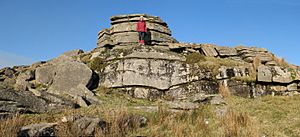Crockern Tor facts for kids
Crockern Tor is a special type of rocky hill called a tor. You can find it in Dartmoor National Park, which is in Devon, England. This tor is made of two big rock piles and stands 396 metres (about 1,300 feet) above sea level.
For hundreds of years, the lower part of Crockern Tor was a very important outdoor meeting place. It was where the Stannary Convocation of Devon, a special court for tin miners, met from the early 1300s until the mid-1700s. People say that the leader of these meetings, called the Lord Warden, would sit on a rock known as Parliament Rock (which you can see in the picture).
Contents
What Makes Crockern Tor Special?
Crockern Tor has been famous for a long time. In the early 1600s, a writer named Tristram Risdon wrote about it in his book, Survey of Devon. He said Crockern Tor had "a table and seats of moorstone [granite], hewn out of the rocks." This means there were tables and chairs made right from the rocks, sitting out in the open weather.
The tor was also one of the few old places shown on a map of Devon made in 1765 by Benjamin Donn. Because it was right next to an old path used by packhorses across Dartmoor, it was a well-known spot for travelers for many, many years.
The Tin Miners' Court
Crockern Tor was like the center point for four areas where tin was mined on Dartmoor: Ashburton, Chagford, Tavistock and Plympton. The boundaries of these areas spread out from the tor like spokes on a wheel.
The special tin miners' court, called the Stannary Court, would meet here when needed. The Lord Warden would call the meetings and gather 24 representatives, or "jurates," from each of the four tin-mining areas. These meetings often lasted for several days. They would decide on tin mining laws, record new tin mines, listen to people's requests, and give out punishments to those who broke the rules.
Famous Meetings at Crockern Tor
We know of at least ten meetings that happened at Crockern Tor. These took place in 1494, 1510, 1532, 1533, 1552, 1567, 1574, 1600, 1688, and 1703. The very first meeting we have records for was on September 1, 1494. Sir John Stepcote was in charge of that meeting.
A very famous person, Sir Walter Raleigh, was the Lord Warden of the Stannaries for many years. Records show he led a court meeting at Crockern Tor on October 27, 1600. The last meeting we have records for was on September 23, 1703. The Lord Warden, John Granville, and his assistant, Samuel Rolle, started the court at 8 a.m. People say the very last court meeting happened around 1745, but there are no official papers to prove it. By then, tin mining on Dartmoor was not as big as it used to be.
What Happened to the Court Furniture?
Some old stories and records suggest that there were chairs, seats, a table, and even a small shelter, all made of granite, at Crockern Tor for the court meetings. These items were supposedly taken away or broken up in the late 1700s. They might have been used as building stones for new houses that started appearing on the moor.
However, some people doubt that big meetings really happened at this windy spot. Douglas St Leger-Gordon, a writer about Devon's history, thought it was a "singularly unsuitable" place. He joked that the wind would often blow away hats or important papers! He also pointed out that later records mention the court sometimes moved to Tavistock. He wondered if a "Tinners' Hall" (a building that is now lost) might have been where they actually did most of their important business.
Folklore and Legends
Crockern Tor is also famous for its legends. People say it is the home of a mythical character called Old Crockern. He is sometimes described as a ghostly figure on horseback, riding across the moor with his phantom dogs. These dogs were supposedly kept at a nearby place called Wistman's Wood.
Other stories say Old Crockern was a local god of the moor from before Christian times. As writer Sabine Baring-Gould described him in 1899:
the gurt old sperit of the moors, Old Crockern himself, grey as granite, and his eyebrows hanging down over his glimmering eyes like sedge, and his eyes as deep as peat water pools.
Panorama



